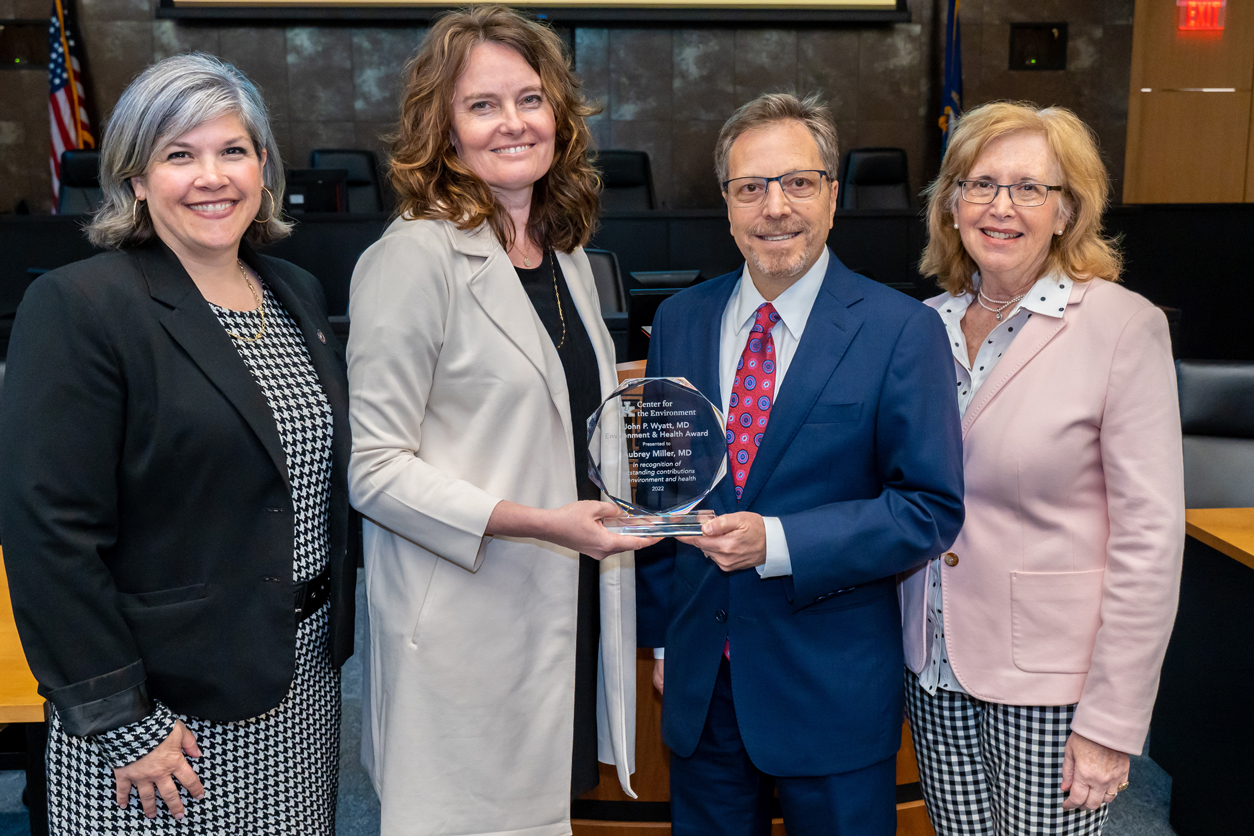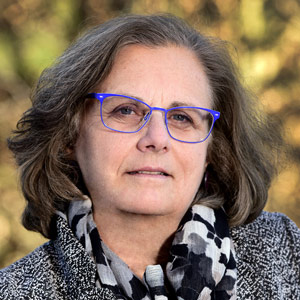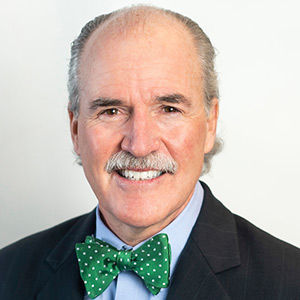NIEHS Senior Medical Advisor Aubrey Miller, M.D., received the John P. Wyatt, M.D. Environment and Health Award on Earth Day, April 22, in recognition of his outstanding contributions to the environment and health.
Miller also presented the keynote lecture at the John P. Wyatt, M.D. Environment and Health Symposium held at the University of Kentucky (UK). The event was hosted by the UK Center for the Environment and co-sponsored by the NIEHS-funded UK Center for Appalachian Research in Environmental Sciences (UK-CARES) and UK Superfund Research Center.
 Kelly Pennell, Ph.D., director, UK Superfund Research Center, Erin Haynes, Dr.PH., director, UK Center for the Environment, and Ellen Hahn, Ph.D., director, UK-CARES, present the John P. Wyatt, M.D. Award to Miller. (Photo courtesy of Ben Corwin / University of Kentucky)
Kelly Pennell, Ph.D., director, UK Superfund Research Center, Erin Haynes, Dr.PH., director, UK Center for the Environment, and Ellen Hahn, Ph.D., director, UK-CARES, present the John P. Wyatt, M.D. Award to Miller. (Photo courtesy of Ben Corwin / University of Kentucky)“Thank you for this honor,” Miller said as he received the award. “I am truly humbled and appreciate this not only for myself but for the team of colleagues that I represent and work with at NIEHS.”
Resiliency in future disasters
Focused on climate-related disasters, Miller’s keynote lecture featured the challenges and opportunities surrounding the health impacts of climate change.
Miller talked about the December 2021 tornadoes that devasted the western Kentucky community of Mayfield and explained how his work is rooted in planning for such disasters by collecting and sharing evidence-based best practices.
The NIEHS Disaster Research Response (DR2) program features a portal of resources for researchers and first responders. The DR2 Centers and Grantees Network, which stretches across the U.S. to Canada and in Japan, aids in developing portal contents. The National Institutes of Health (NIH) asked Miller to replicate the DR2 Portal(https://tools.niehs.nih.gov/dr2/) for NIH’s COVID-19 research response.
NIEHS grantee Natasha DeJarnett, Ph.D., a professor at the University of Louisville, moderated a panel session on climate change and public health at the symposium.
“This panel shared such powerful storytelling and imagery that has really brought to life the climate impacts that we’re experiencing,” DeJarnett said. “Overarching themes include threats to physical and mental health, but through it all, what I’ve heard echoing is our resilience.”
Earth Day starts at home
Just as Miller plans for climate-related disasters, the NIEHS Environmental Awareness and Advisory Committee encourages use of blue-sky days by conserving and converting energy (see sidebar) and building sustainable native habitats. Two Earth Day seminars highlighted the actions that begin at home to create a healthier Earth in the years to come.
 Kerri Hartung, NIEHS sustainability coordinator, and Paul Johnson, NIEHS Environmental Protection and Stewardship Programs manager, hosted the dual Earth Day events. (Photos courtesy of Steve McCaw / NIEHS)
Kerri Hartung, NIEHS sustainability coordinator, and Paul Johnson, NIEHS Environmental Protection and Stewardship Programs manager, hosted the dual Earth Day events. (Photos courtesy of Steve McCaw / NIEHS)Native plants and natural ecosystems were the focus of the first seminar held April 19, which featured naturalist Pete Schubert with the NC Invasive Plant Council and New Hope Audubon Society, a retired engineer from the U.S. Environmental Protection Agency.
Growing native plants can improve the habitat quality of your home, and removing non-native plants can be just as imperative, Schubert said, describing some non-native, invasive plants as malignancies. The definitions and warnings he offered are as follows.
- Natives are plants that grow locally before Europeans came to the new world. Native plants are considered ecosystem food.
- Non-natives are those that have been introduced from somewhere else purposefully or by accident. Non-native plants are considered ecosystem pollution.
- Invasives are non-native plants that spread uncontrollably far beyond where initially planted. Invasive plants can harm ecosystems, disrupt food webs, and are considered malignant ecosystem pollution.
Removing non-native plants, stopping invasive plants, and adding native plants are important steps in maintaining bird-friendly habitats, which are critical to the ecosystem, according to Schubert. The National Wildlife Federation’s plant finder database is searchable by zip code so gardeners can search for plants native to their area.
Habitats welcoming to caterpillars are important because birds need caterpillars to survive, he added. The North Carolina Native Plant Society offers a searchable native butterfly database.
Increasing the number of native plants on the NIEHS campus around Discovery Lake and identifying plants at nurseries that have been sprayed with pesticides were among the topics discussed by seminar attendees following Schubert’s talk.
(Jennifer Harker, Ph.D., is a technical writer-editor in the NIEHS Office of Communications and Public Liaison.)









